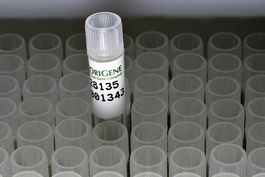TAS2R38 (NM_176817) Human Tagged ORF Clone
CAT#: RC211209L3
- LentiORF®
Lenti ORF clone of Human taste receptor, type 2, member 38 (TAS2R38), Myc-DDK-tagged
"NM_176817" in other vectors (6)
Product Images

Specifications
| Product Data | |
| Type | Human Tagged ORF Clone |
| Tag | Myc-DDK |
| Symbol | TAS2R38 |
| Synonyms | PTC; T2R38; T2R61; THIOT |
| Vector | pLenti-C-Myc-DDK-P2A-Puro |
| E. coli Selection | Chloramphenicol (34 ug/mL) |
| Mammalian Cell Selection | Puromycin |
| Sequence Data |
The ORF insert of this clone is exactly the same as(RC211209).
|
| Restriction Sites | SgfI-MluI Cloning Scheme for this gene |
| ACCN | NM_176817 |
| ORF Size | 999 bp |
| OTI Disclaimer | The molecular sequence of this clone aligns with the gene accession number as a point of reference only. However, individual transcript sequences of the same gene can differ through naturally occurring variations (e.g. polymorphisms), each with its own valid existence. This clone is substantially in agreement with the reference, but a complete review of all prevailing variants is recommended prior to use. More info |
| OTI Annotation | This clone was engineered to express the complete ORF with an expression tag. Expression varies depending on the nature of the gene. |
| Product Components | The ORF clone is ion-exchange column purified, transfection-ready dried plasmid DNA, and shipped with 2 vector sequencing primers. |
| Reconstitution | 1. Centrifuge at 5,000xg for 5min. 2. Carefully open the tube and add 100ul of sterile water to dissolve the DNA. 3. Close the tube and incubate for 10 minutes at room temperature. 4. Briefly vortex the tube and then do a quick spin (less than 5000xg) to concentrate the liquid at the bottom. 5. Store the suspended plasmid at -20°C. The DNA is stable for at least one year from date of shipping when stored at -20°C. |
| Reference Data | |
| RefSeq | NM_176817.2, NP_789787.2 |
| RefSeq Size | 1143 bp |
| RefSeq ORF | 1002 bp |
| Locus ID | 5726 |
| Cytogenetics | 7q34 |
| Protein Families | Druggable Genome, Transmembrane |
| Protein Pathways | Taste transduction |
| MW | 37.9 kDa |
| Gene Summary | 'This gene encodes a seven-transmembrane G protein-coupled receptor that controls the ability to taste glucosinolates, a family of bitter-tasting compounds found in plants of the Brassica sp. Synthetic compounds phenylthiocarbamide (PTC) and 6-n-propylthiouracil (PROP) have been identified as ligands for this receptor and have been used to test the genetic diversity of this gene. Although several allelic forms of this gene have been identified worldwide, there are two predominant common forms (taster and non-taster) found outside of Africa. These alleles differ at three nucleotide positions resulting in amino acid changes in the protein (A49P, A262V, and V296I) with the amino acid combination PAV identifying the taster variant (and AVI identifying the non-taster variant). [provided by RefSeq, Oct 2009]' |
Documents
| Product Manuals |
| FAQs |
Resources
Other Versions
| SKU | Description | Size | Price |
|---|---|---|---|
| SC307069 | TAS2R38 (untagged)-Human taste receptor, type 2, member 38 (TAS2R38) |
USD 760.00 |
|
| RC211209 | TAS2R38 (Myc-DDK-tagged)-Human taste receptor, type 2, member 38 (TAS2R38) |
USD 420.00 |
|
| RG211209 | TAS2R38 (GFP-tagged) - Human taste receptor, type 2, member 38 (TAS2R38) |
USD 460.00 |
|
| RC211209L1 | Lenti ORF clone of Human taste receptor, type 2, member 38 (TAS2R38), Myc-DDK-tagged |
USD 768.00 |
|
| RC211209L2 | Lenti ORF clone of Human taste receptor, type 2, member 38 (TAS2R38), mGFP tagged |
USD 620.00 |
|
| RC211209L4 | Lenti ORF clone of Human taste receptor, type 2, member 38 (TAS2R38), mGFP tagged |
USD 620.00 |
{0} Product Review(s)
Be the first one to submit a review






























































































































































































































































 Germany
Germany
 Japan
Japan
 United Kingdom
United Kingdom
 China
China

